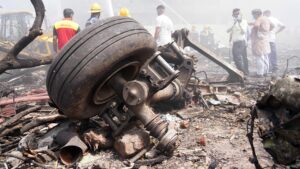Tragedy in Aviation: Air India Boeing 787 Dreamliner Crash Analysis
On June 12, 2025, a tragic aviation incident occurred when an Air India Boeing 787 Dreamliner, carrying 242 passengers, crashed shortly after takeoff from Ahmedabad’s Sardar Vallabhbhai Patel International Airport, heading to London’s Gatwick Airport. Miraculously, one passenger survived the disaster, but the event marks the first crash of a Boeing 787 Dreamliner and stands as one of the deadliest plane crashes in years. Here’s a closer look at the implications of this tragedy and what it means for the aviation industry.
The Boeing 787: A Modern Marvel
The aircraft involved in the crash was a Boeing 787-8 Dreamliner, known for its advanced technology and efficiency on long-haul routes. First delivered to Air India in January 2014, it was part of a growing fleet that represented a shift towards modern aviation. With over 1,100 Dreamliners currently in operation worldwide, the aircraft has been celebrated for its design and comfort. Air India had plans to expand its fleet further, proving the airline’s commitment to modernizing its services.
What Transpired During the Flight?
The accident unfolded just 38 seconds after takeoff, a time frame that raises critical questions. Preliminary data from flight tracking service Flightradar24 indicates that the aircraft reached an altitude of only 625 feet before losing communication with air traffic control, crashing into a residential area. Given that the airport’s elevation is approximately 200 feet, this rapid descent is alarming, and investigations are underway to uncover the causes. Possible contributing factors could range from mechanical failures to pilot error.
Investigative Measures Underway
In the quest for answers, investigators will focus on extracting data from the flight’s black boxes—vital cockpit and flight-data recorders. They will scrutinize a variety of elements including the aircraft’s maintenance logs, pilot training records, as well as the intricate technical specifications related to flight maneuvers and performance. Considering the ambient conditions of nearly 100°F, weather may also play a role in the early assessment.
Manufacturing Concerns: Is There a Connection?
While past manufacturing issues have circled the Boeing 787’s reputation—ranging from lithium battery fire hazards to quality control checks—experts do not immediately correlate these with the current disaster. Jeff Guzzetti, a retired air safety investigator, commented that current signs do not suggest a direct link to manufacturing flaws. However, Boeing has faced scrutiny in the past; a whistleblower recently alleged shortcuts in production processes, compounding concerns about the aircraft’s integrity.
The Impact on Boeing and the Aviation Industry
In light of this and previous incidents involving Boeing, the company finds itself navigating turbulent waters. With demand for new aircraft remaining robust, previously placed orders are unlikely to be affected substantially—at least in the short term. Analysts from Wolfe Research suggest that while this incident will temper Boeing’s momentum, the broader implications for production and demand may still be minimal.
The Road Ahead
As investigations unfold, the aviation community will be watching closely. A thorough examination of the incident will not only shed light on the causes but also help redefine safety protocols within the industry. At Extreme Investor Network, we remain committed to keeping you informed of significant developments in aviation and their implications for the global market.
This tragic event serves as a stark reminder of the risks associated with air travel and the responsibilities of manufacturers and regulators alike. It’s essential for stakeholders to prioritize safety in the ever-evolving field of aviation.
Stay tuned for updates as we continue to follow this story and provide insights that matter to our readers.

